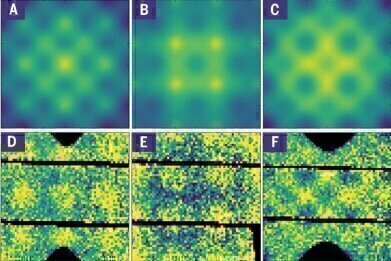-
 A comparison of the theoretical calculations (top row) and inelastic neutron scattering data (bottom row) shows the excellent agreement between the two. The three figures represent different slices through the four-dimensional scattering volumes produced by the electronic excitations. (Credit: Argonne National Laboratory)
A comparison of the theoretical calculations (top row) and inelastic neutron scattering data (bottom row) shows the excellent agreement between the two. The three figures represent different slices through the four-dimensional scattering volumes produced by the electronic excitations. (Credit: Argonne National Laboratory)
News
Study Highlights Usefulness of Theoretical Predictions
Feb 27 2018
An international team of scientists have utilised the UK’s neutron and muon source, the ISIS facility, to study the structure of electrons in useful materials – such as those with superconductivity or magnetism.
The experimental techniques often used to study electrons, such as photoemission spectroscopy have limitations, but until recently it was not thought to be feasible to measure the electronic structure of materials with correlated electrons using neutrons.
However, a team of researchers led by the US Department of Energy’s Argonne National Laboratory have successfully used the Merlin Instrument at STFC’s ISIS facility using neutron scattering to see how electrons behave at high or low temperatures – and compared these results to the theoretical predictions.
STFC scientist Dr Devashibhai Adroja said: “Merlin was the perfect piece of equipment for this experiment because it is designed to study the behaviour of electrons in correlated materials like these. Neutron scattering is vital because it can comprehensively witness the electrons interacting in four dimensions, making it the only technique able to create results which can be compared to the theoretical calculations.”
Dr Ray Osborn, a senior scientist at Argonne, said: "Neutrons are absolutely essential for this research. Neutron scattering is the only technique that is sensitive to the whole spectrum of electronic fluctuations in four dimensions of momentum and energy and the only technique that can be reliably compared to realistic theoretical calculations on an absolute intensity scale."
In projects where the gap between the experimental results and theoretical models becomes narrower, computer simulations could be considered a key tool in the discovery of new materials and probing their uses through materials engineering.
Digital Edition
Lab Asia Dec 2025
December 2025
Chromatography Articles- Cutting-edge sample preparation tools help laboratories to stay ahead of the curveMass Spectrometry & Spectroscopy Articles- Unlocking the complexity of metabolomics: Pushi...
View all digital editions
Events
Jan 21 2026 Tokyo, Japan
Jan 28 2026 Tokyo, Japan
Jan 29 2026 New Delhi, India
Feb 07 2026 Boston, MA, USA
Asia Pharma Expo/Asia Lab Expo
Feb 12 2026 Dhaka, Bangladesh


















